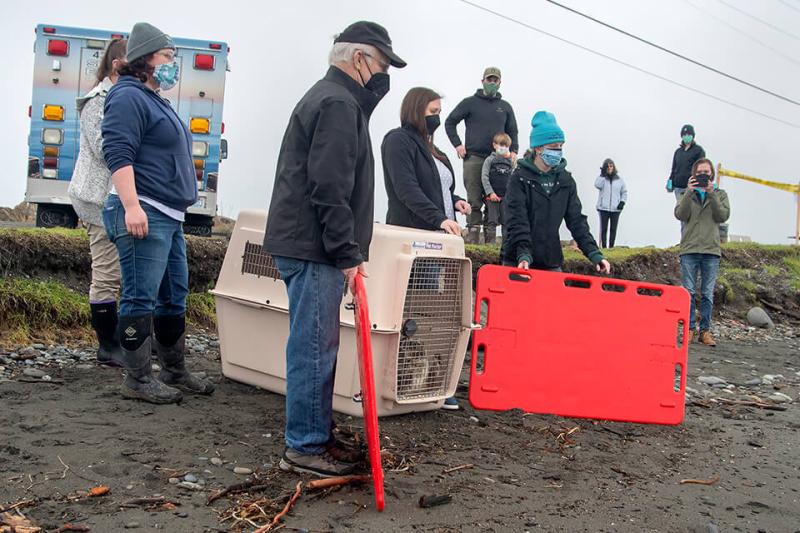Feiro Marine Life Center, a small organization focused on education and marine mammal stranding response, covers a large portion of Clallam County in Washington state. Feiro’s Marine Mammal Stranding Program has 12 volunteers who assist with animal assessments, communications, data collection, and the distribution of educational information about marine life. The organization’s mission includes contributing “to a strong community by providing local marine and watershed learning experiences, inspiring us all to act on behalf of our environment.”
The program responds to strandings (PDF, 1 page) from Port Williams Beach near Sequim, Washington, to the Makah Reservation on the north side of the Olympic Peninsula. The Center was named after Arthur Feiro, a teacher who envisioned it as a classroom, museum, and science lab. It has been a part of the community of Port Angeles since the 1970s. It hosts an aquarium and history exhibits for visitors, as well as youth programs, and an annual speaker series that highlights current marine and watershed issues.
Feiro saw a need for marine mammal response in the community and decided to join the Marine Mammal Stranding Network. NOAA’s West Coast Marine Mammal Stranding Network is composed of partner organizations along the coast. They play an essential role in helping NOAA Fisheries monitor and recover protected marine mammals, including endangered and threatened species.
Saving an Out-of-Place Orca
Melissa Williams, Executive Director of the Feiro Marine Life Center, recalls a case involving a young transient killer whale, later identified as T65A5. It was trapped in a lagoon and separated from the Port Angeles harbor by a narrow causeway. The Center received a late night call from the Washington Department of Fish and Wildlife, alerting the team.
Tamara Galvan, Facilities Director and Stranding Lead for Fiero, traveled to the lagoon. She supplied continuous reports of the animal’s location to Cascadia Research Collective and NOAA Fisheries while the teams mobilized.
The transient orca entered a canal leading into the small lagoon at a paper mill in Port Angeles, Washington. To get out, the animal had to return through the canal under a busy bridge. The teams were concerned that the whale would not find its way back before low tide.
Local law enforcement stopped the traffic over the causeway as the whale approached. With the traffic stopped, the whale saw its chance and swam back out into the harbor and eventually back to the Strait of Juan de Fuca. The Feiro team and all the partner organizations breathed a sigh of relief.
Strength of Community
The human dimension is an important aspect of protecting marine life. Educating people about wildlife behavior, and encouraging collaboration, involvement, and responsible viewing, are all vital to conservation efforts. Stranding Network partners respond to incidents, communicate with experts, and coordinate with local law enforcement in emergencies.
Responding to marine mammal stranding events is challenging work. It requires trained professionals with the right equipment, knowledge, and experience to ensure the safety of the animal and the responders.
If you see an animal in distress, call the Marine Mammal Stranding Network instead of attempting to rescue the animal. Stressed marine mammals have been known to scratch, bite, and injure humans. Some stranded marine mammals also carry diseases that are transmissible to humans and pets. Experts can interpret and assess the stranding event and determine the best course of action.
Feiro also emphasizes education and outreach to build public awareness around marine life, highlighting “Share the Shore” principles for responsible wildlife viewing practices.
“Our favorite success stories are not about any particular animal, but about the humans in our community,” Executive Director Williams said.
How to Help Wildlife Responsibly
First, determine if the animal is truly stranded. A whale, dolphin, or porpoise on the beach should be called in immediately. But many seals and sea lions that haul out and rest on land are not in distress. You can evaluate the animal’s behavior from a distance, and monitor their condition for 24 hours. Let others who are nearby know to stay at least 100 yards away (about the length of a football field). Keep pets 100 yards away, help minimize disturbances if possible, and be aware of hazards or rising tides and monitor from an area that is safe. To report a dead, injured, or stranded marine mammal along the West Coast, please contact the West Coast Region Stranding Hotline at (866) 767-6114.



